The Role of Leadership in Fostering Innovation and Strategy
VerifiedAdded on 2022/08/21
|9
|2881
|12
Essay
AI Summary
This essay explores the critical role of strategic leadership in fostering innovation and creativity within organizations. It emphasizes the increasing pressure on organizations to develop innovative solutions in a dynamic environment, highlighting how leaders can facilitate team innovation. The discussion covers various theories, including transformational leadership, and their impact on employee creativity and organizational innovation. Real-world examples, such as 3M and Elon Musk's leadership at Tesla, illustrate the importance of leadership in creating a culture that values innovation and empowers employees. The essay concludes that effective leadership involves relaxing restrictions, aligning individuals with tasks, and fostering a creative culture to nurture innovation at all levels, ultimately leading to increased productivity and organizational success. The website Desklib offers similar essays and resources for students.
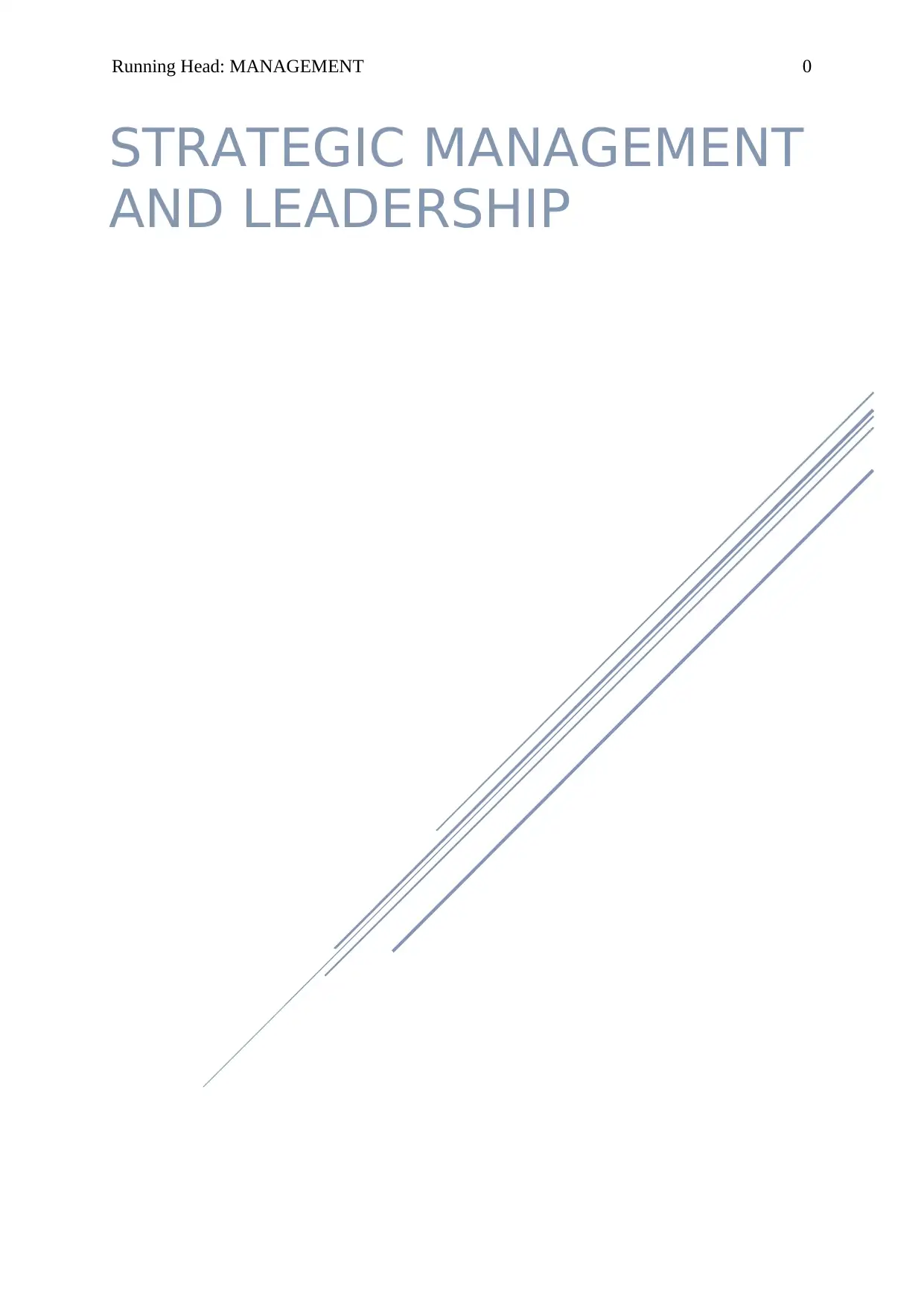
Running Head: MANAGEMENT 0
`
STRATEGIC MANAGEMENT
AND LEADERSHIP
`
STRATEGIC MANAGEMENT
AND LEADERSHIP
Paraphrase This Document
Need a fresh take? Get an instant paraphrase of this document with our AI Paraphraser
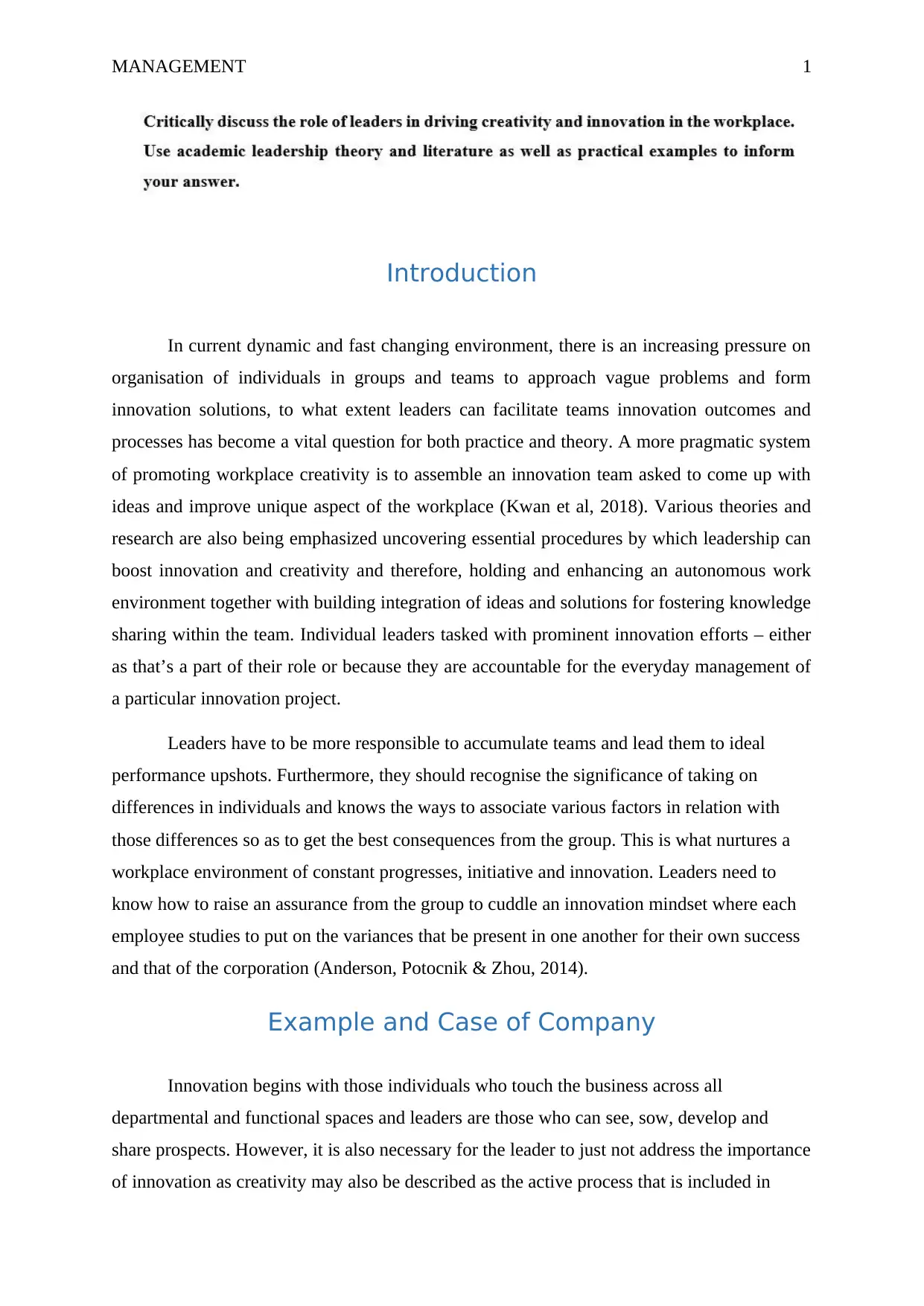
MANAGEMENT 1
Introduction
In current dynamic and fast changing environment, there is an increasing pressure on
organisation of individuals in groups and teams to approach vague problems and form
innovation solutions, to what extent leaders can facilitate teams innovation outcomes and
processes has become a vital question for both practice and theory. A more pragmatic system
of promoting workplace creativity is to assemble an innovation team asked to come up with
ideas and improve unique aspect of the workplace (Kwan et al, 2018). Various theories and
research are also being emphasized uncovering essential procedures by which leadership can
boost innovation and creativity and therefore, holding and enhancing an autonomous work
environment together with building integration of ideas and solutions for fostering knowledge
sharing within the team. Individual leaders tasked with prominent innovation efforts – either
as that’s a part of their role or because they are accountable for the everyday management of
a particular innovation project.
Leaders have to be more responsible to accumulate teams and lead them to ideal
performance upshots. Furthermore, they should recognise the significance of taking on
differences in individuals and knows the ways to associate various factors in relation with
those differences so as to get the best consequences from the group. This is what nurtures a
workplace environment of constant progresses, initiative and innovation. Leaders need to
know how to raise an assurance from the group to cuddle an innovation mindset where each
employee studies to put on the variances that be present in one another for their own success
and that of the corporation (Anderson, Potocnik & Zhou, 2014).
Example and Case of Company
Innovation begins with those individuals who touch the business across all
departmental and functional spaces and leaders are those who can see, sow, develop and
share prospects. However, it is also necessary for the leader to just not address the importance
of innovation as creativity may also be described as the active process that is included in
Introduction
In current dynamic and fast changing environment, there is an increasing pressure on
organisation of individuals in groups and teams to approach vague problems and form
innovation solutions, to what extent leaders can facilitate teams innovation outcomes and
processes has become a vital question for both practice and theory. A more pragmatic system
of promoting workplace creativity is to assemble an innovation team asked to come up with
ideas and improve unique aspect of the workplace (Kwan et al, 2018). Various theories and
research are also being emphasized uncovering essential procedures by which leadership can
boost innovation and creativity and therefore, holding and enhancing an autonomous work
environment together with building integration of ideas and solutions for fostering knowledge
sharing within the team. Individual leaders tasked with prominent innovation efforts – either
as that’s a part of their role or because they are accountable for the everyday management of
a particular innovation project.
Leaders have to be more responsible to accumulate teams and lead them to ideal
performance upshots. Furthermore, they should recognise the significance of taking on
differences in individuals and knows the ways to associate various factors in relation with
those differences so as to get the best consequences from the group. This is what nurtures a
workplace environment of constant progresses, initiative and innovation. Leaders need to
know how to raise an assurance from the group to cuddle an innovation mindset where each
employee studies to put on the variances that be present in one another for their own success
and that of the corporation (Anderson, Potocnik & Zhou, 2014).
Example and Case of Company
Innovation begins with those individuals who touch the business across all
departmental and functional spaces and leaders are those who can see, sow, develop and
share prospects. However, it is also necessary for the leader to just not address the importance
of innovation as creativity may also be described as the active process that is included in
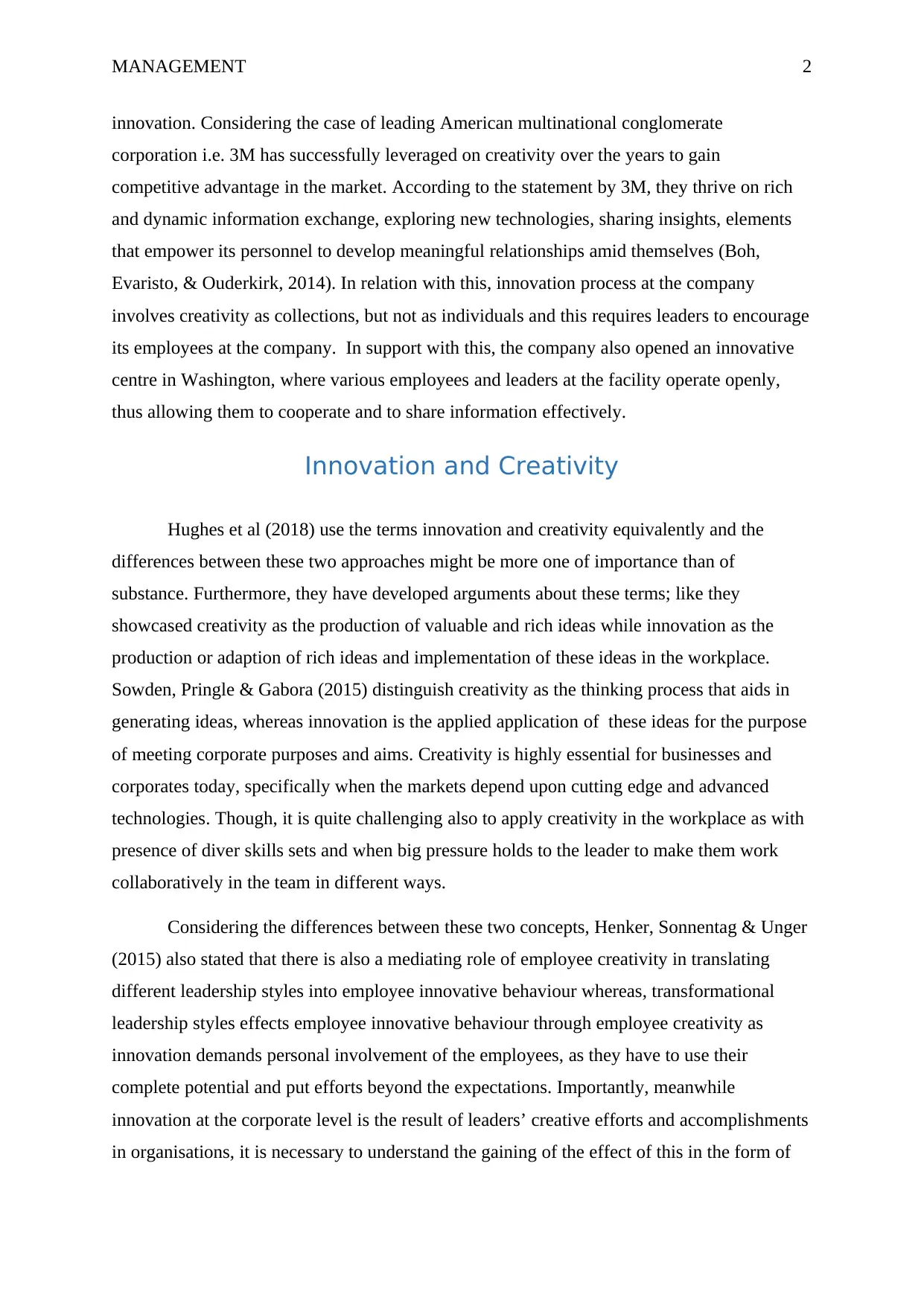
MANAGEMENT 2
innovation. Considering the case of leading American multinational conglomerate
corporation i.e. 3M has successfully leveraged on creativity over the years to gain
competitive advantage in the market. According to the statement by 3M, they thrive on rich
and dynamic information exchange, exploring new technologies, sharing insights, elements
that empower its personnel to develop meaningful relationships amid themselves (Boh,
Evaristo, & Ouderkirk, 2014). In relation with this, innovation process at the company
involves creativity as collections, but not as individuals and this requires leaders to encourage
its employees at the company. In support with this, the company also opened an innovative
centre in Washington, where various employees and leaders at the facility operate openly,
thus allowing them to cooperate and to share information effectively.
Innovation and Creativity
Hughes et al (2018) use the terms innovation and creativity equivalently and the
differences between these two approaches might be more one of importance than of
substance. Furthermore, they have developed arguments about these terms; like they
showcased creativity as the production of valuable and rich ideas while innovation as the
production or adaption of rich ideas and implementation of these ideas in the workplace.
Sowden, Pringle & Gabora (2015) distinguish creativity as the thinking process that aids in
generating ideas, whereas innovation is the applied application of these ideas for the purpose
of meeting corporate purposes and aims. Creativity is highly essential for businesses and
corporates today, specifically when the markets depend upon cutting edge and advanced
technologies. Though, it is quite challenging also to apply creativity in the workplace as with
presence of diver skills sets and when big pressure holds to the leader to make them work
collaboratively in the team in different ways.
Considering the differences between these two concepts, Henker, Sonnentag & Unger
(2015) also stated that there is also a mediating role of employee creativity in translating
different leadership styles into employee innovative behaviour whereas, transformational
leadership styles effects employee innovative behaviour through employee creativity as
innovation demands personal involvement of the employees, as they have to use their
complete potential and put efforts beyond the expectations. Importantly, meanwhile
innovation at the corporate level is the result of leaders’ creative efforts and accomplishments
in organisations, it is necessary to understand the gaining of the effect of this in the form of
innovation. Considering the case of leading American multinational conglomerate
corporation i.e. 3M has successfully leveraged on creativity over the years to gain
competitive advantage in the market. According to the statement by 3M, they thrive on rich
and dynamic information exchange, exploring new technologies, sharing insights, elements
that empower its personnel to develop meaningful relationships amid themselves (Boh,
Evaristo, & Ouderkirk, 2014). In relation with this, innovation process at the company
involves creativity as collections, but not as individuals and this requires leaders to encourage
its employees at the company. In support with this, the company also opened an innovative
centre in Washington, where various employees and leaders at the facility operate openly,
thus allowing them to cooperate and to share information effectively.
Innovation and Creativity
Hughes et al (2018) use the terms innovation and creativity equivalently and the
differences between these two approaches might be more one of importance than of
substance. Furthermore, they have developed arguments about these terms; like they
showcased creativity as the production of valuable and rich ideas while innovation as the
production or adaption of rich ideas and implementation of these ideas in the workplace.
Sowden, Pringle & Gabora (2015) distinguish creativity as the thinking process that aids in
generating ideas, whereas innovation is the applied application of these ideas for the purpose
of meeting corporate purposes and aims. Creativity is highly essential for businesses and
corporates today, specifically when the markets depend upon cutting edge and advanced
technologies. Though, it is quite challenging also to apply creativity in the workplace as with
presence of diver skills sets and when big pressure holds to the leader to make them work
collaboratively in the team in different ways.
Considering the differences between these two concepts, Henker, Sonnentag & Unger
(2015) also stated that there is also a mediating role of employee creativity in translating
different leadership styles into employee innovative behaviour whereas, transformational
leadership styles effects employee innovative behaviour through employee creativity as
innovation demands personal involvement of the employees, as they have to use their
complete potential and put efforts beyond the expectations. Importantly, meanwhile
innovation at the corporate level is the result of leaders’ creative efforts and accomplishments
in organisations, it is necessary to understand the gaining of the effect of this in the form of
⊘ This is a preview!⊘
Do you want full access?
Subscribe today to unlock all pages.

Trusted by 1+ million students worldwide
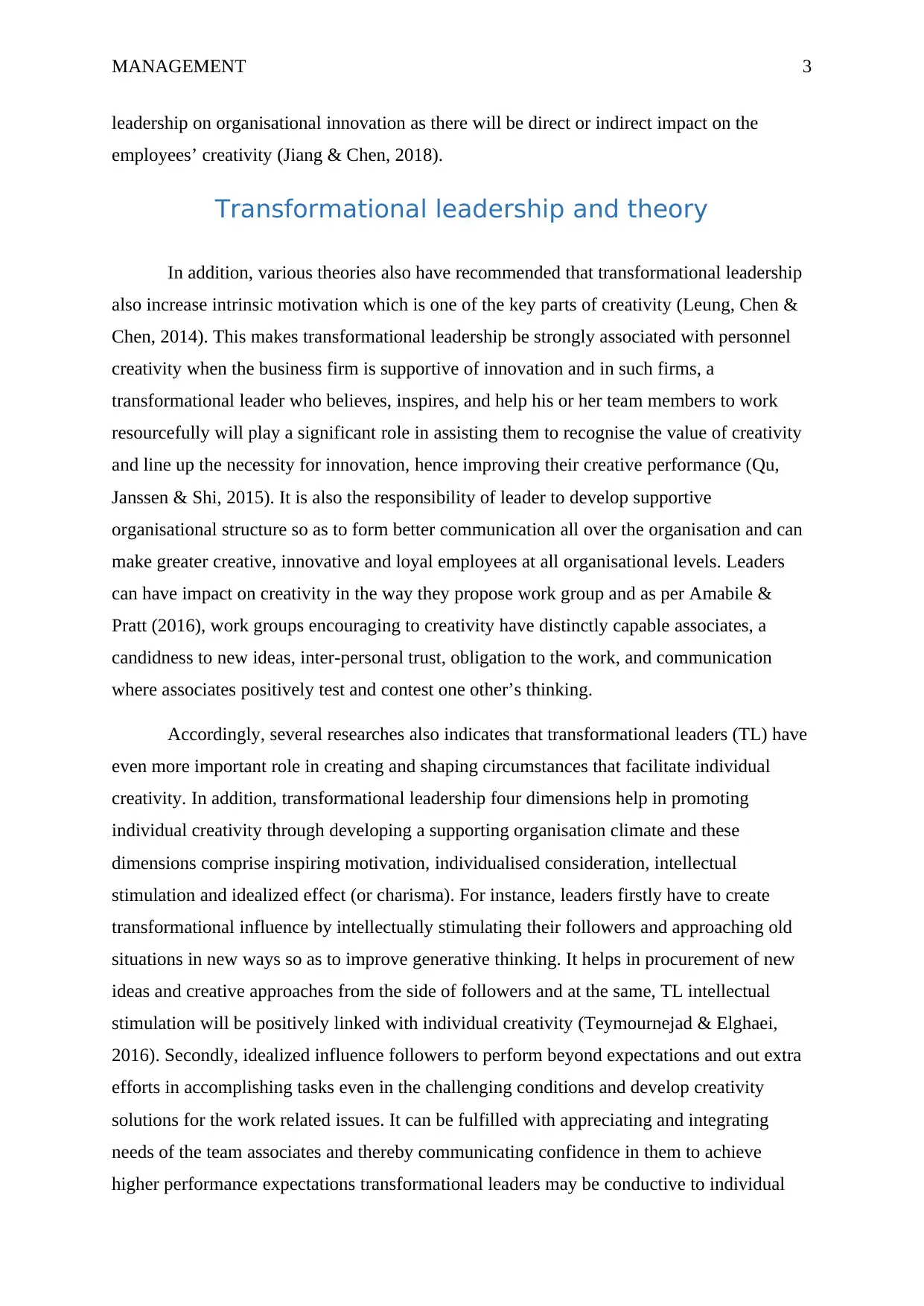
MANAGEMENT 3
leadership on organisational innovation as there will be direct or indirect impact on the
employees’ creativity (Jiang & Chen, 2018).
Transformational leadership and theory
In addition, various theories also have recommended that transformational leadership
also increase intrinsic motivation which is one of the key parts of creativity (Leung, Chen &
Chen, 2014). This makes transformational leadership be strongly associated with personnel
creativity when the business firm is supportive of innovation and in such firms, a
transformational leader who believes, inspires, and help his or her team members to work
resourcefully will play a significant role in assisting them to recognise the value of creativity
and line up the necessity for innovation, hence improving their creative performance (Qu,
Janssen & Shi, 2015). It is also the responsibility of leader to develop supportive
organisational structure so as to form better communication all over the organisation and can
make greater creative, innovative and loyal employees at all organisational levels. Leaders
can have impact on creativity in the way they propose work group and as per Amabile &
Pratt (2016), work groups encouraging to creativity have distinctly capable associates, a
candidness to new ideas, inter-personal trust, obligation to the work, and communication
where associates positively test and contest one other’s thinking.
Accordingly, several researches also indicates that transformational leaders (TL) have
even more important role in creating and shaping circumstances that facilitate individual
creativity. In addition, transformational leadership four dimensions help in promoting
individual creativity through developing a supporting organisation climate and these
dimensions comprise inspiring motivation, individualised consideration, intellectual
stimulation and idealized effect (or charisma). For instance, leaders firstly have to create
transformational influence by intellectually stimulating their followers and approaching old
situations in new ways so as to improve generative thinking. It helps in procurement of new
ideas and creative approaches from the side of followers and at the same, TL intellectual
stimulation will be positively linked with individual creativity (Teymournejad & Elghaei,
2016). Secondly, idealized influence followers to perform beyond expectations and out extra
efforts in accomplishing tasks even in the challenging conditions and develop creativity
solutions for the work related issues. It can be fulfilled with appreciating and integrating
needs of the team associates and thereby communicating confidence in them to achieve
higher performance expectations transformational leaders may be conductive to individual
leadership on organisational innovation as there will be direct or indirect impact on the
employees’ creativity (Jiang & Chen, 2018).
Transformational leadership and theory
In addition, various theories also have recommended that transformational leadership
also increase intrinsic motivation which is one of the key parts of creativity (Leung, Chen &
Chen, 2014). This makes transformational leadership be strongly associated with personnel
creativity when the business firm is supportive of innovation and in such firms, a
transformational leader who believes, inspires, and help his or her team members to work
resourcefully will play a significant role in assisting them to recognise the value of creativity
and line up the necessity for innovation, hence improving their creative performance (Qu,
Janssen & Shi, 2015). It is also the responsibility of leader to develop supportive
organisational structure so as to form better communication all over the organisation and can
make greater creative, innovative and loyal employees at all organisational levels. Leaders
can have impact on creativity in the way they propose work group and as per Amabile &
Pratt (2016), work groups encouraging to creativity have distinctly capable associates, a
candidness to new ideas, inter-personal trust, obligation to the work, and communication
where associates positively test and contest one other’s thinking.
Accordingly, several researches also indicates that transformational leaders (TL) have
even more important role in creating and shaping circumstances that facilitate individual
creativity. In addition, transformational leadership four dimensions help in promoting
individual creativity through developing a supporting organisation climate and these
dimensions comprise inspiring motivation, individualised consideration, intellectual
stimulation and idealized effect (or charisma). For instance, leaders firstly have to create
transformational influence by intellectually stimulating their followers and approaching old
situations in new ways so as to improve generative thinking. It helps in procurement of new
ideas and creative approaches from the side of followers and at the same, TL intellectual
stimulation will be positively linked with individual creativity (Teymournejad & Elghaei,
2016). Secondly, idealized influence followers to perform beyond expectations and out extra
efforts in accomplishing tasks even in the challenging conditions and develop creativity
solutions for the work related issues. It can be fulfilled with appreciating and integrating
needs of the team associates and thereby communicating confidence in them to achieve
higher performance expectations transformational leaders may be conductive to individual
Paraphrase This Document
Need a fresh take? Get an instant paraphrase of this document with our AI Paraphraser
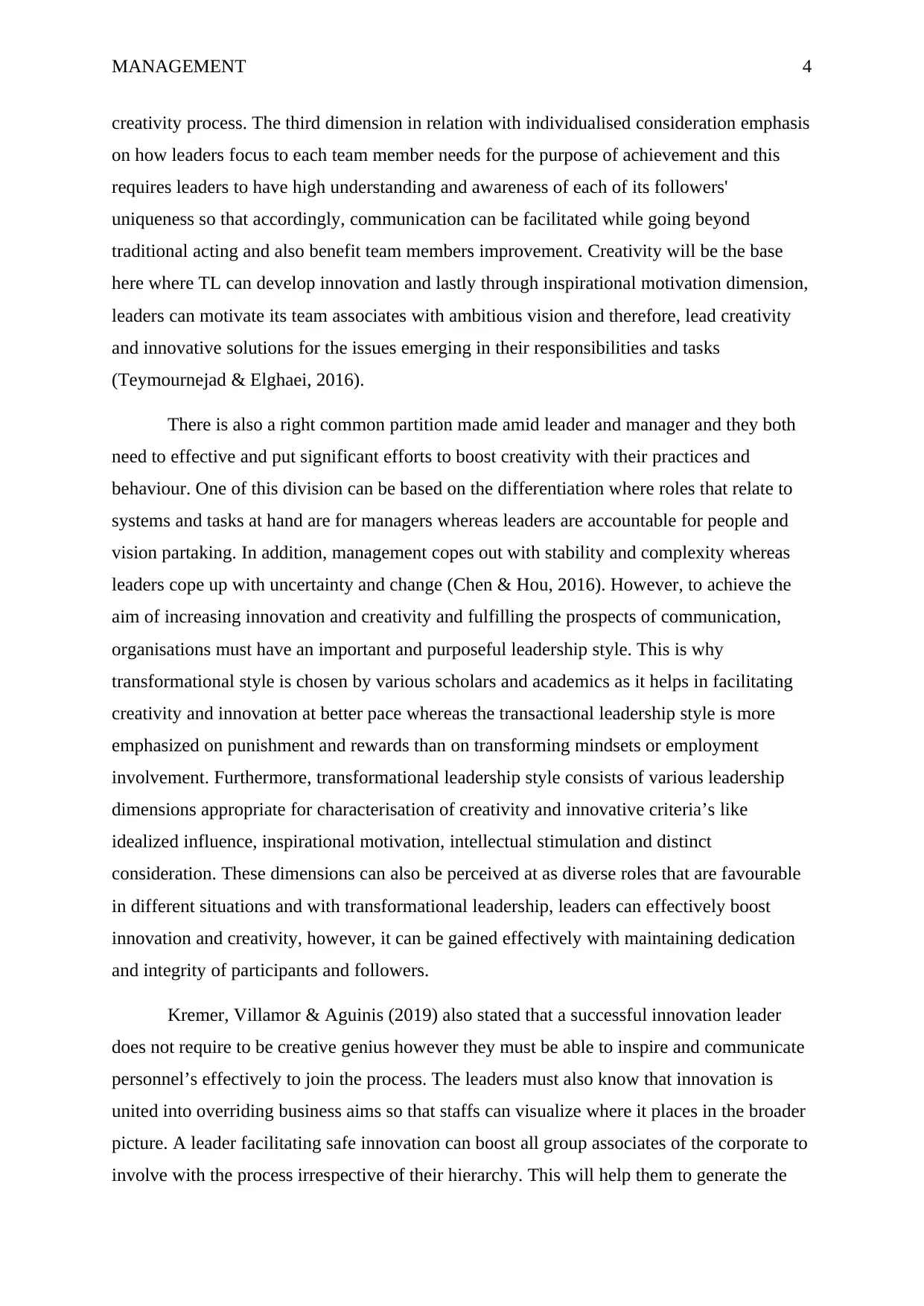
MANAGEMENT 4
creativity process. The third dimension in relation with individualised consideration emphasis
on how leaders focus to each team member needs for the purpose of achievement and this
requires leaders to have high understanding and awareness of each of its followers'
uniqueness so that accordingly, communication can be facilitated while going beyond
traditional acting and also benefit team members improvement. Creativity will be the base
here where TL can develop innovation and lastly through inspirational motivation dimension,
leaders can motivate its team associates with ambitious vision and therefore, lead creativity
and innovative solutions for the issues emerging in their responsibilities and tasks
(Teymournejad & Elghaei, 2016).
There is also a right common partition made amid leader and manager and they both
need to effective and put significant efforts to boost creativity with their practices and
behaviour. One of this division can be based on the differentiation where roles that relate to
systems and tasks at hand are for managers whereas leaders are accountable for people and
vision partaking. In addition, management copes out with stability and complexity whereas
leaders cope up with uncertainty and change (Chen & Hou, 2016). However, to achieve the
aim of increasing innovation and creativity and fulfilling the prospects of communication,
organisations must have an important and purposeful leadership style. This is why
transformational style is chosen by various scholars and academics as it helps in facilitating
creativity and innovation at better pace whereas the transactional leadership style is more
emphasized on punishment and rewards than on transforming mindsets or employment
involvement. Furthermore, transformational leadership style consists of various leadership
dimensions appropriate for characterisation of creativity and innovative criteria’s like
idealized influence, inspirational motivation, intellectual stimulation and distinct
consideration. These dimensions can also be perceived at as diverse roles that are favourable
in different situations and with transformational leadership, leaders can effectively boost
innovation and creativity, however, it can be gained effectively with maintaining dedication
and integrity of participants and followers.
Kremer, Villamor & Aguinis (2019) also stated that a successful innovation leader
does not require to be creative genius however they must be able to inspire and communicate
personnel’s effectively to join the process. The leaders must also know that innovation is
united into overriding business aims so that staffs can visualize where it places in the broader
picture. A leader facilitating safe innovation can boost all group associates of the corporate to
involve with the process irrespective of their hierarchy. This will help them to generate the
creativity process. The third dimension in relation with individualised consideration emphasis
on how leaders focus to each team member needs for the purpose of achievement and this
requires leaders to have high understanding and awareness of each of its followers'
uniqueness so that accordingly, communication can be facilitated while going beyond
traditional acting and also benefit team members improvement. Creativity will be the base
here where TL can develop innovation and lastly through inspirational motivation dimension,
leaders can motivate its team associates with ambitious vision and therefore, lead creativity
and innovative solutions for the issues emerging in their responsibilities and tasks
(Teymournejad & Elghaei, 2016).
There is also a right common partition made amid leader and manager and they both
need to effective and put significant efforts to boost creativity with their practices and
behaviour. One of this division can be based on the differentiation where roles that relate to
systems and tasks at hand are for managers whereas leaders are accountable for people and
vision partaking. In addition, management copes out with stability and complexity whereas
leaders cope up with uncertainty and change (Chen & Hou, 2016). However, to achieve the
aim of increasing innovation and creativity and fulfilling the prospects of communication,
organisations must have an important and purposeful leadership style. This is why
transformational style is chosen by various scholars and academics as it helps in facilitating
creativity and innovation at better pace whereas the transactional leadership style is more
emphasized on punishment and rewards than on transforming mindsets or employment
involvement. Furthermore, transformational leadership style consists of various leadership
dimensions appropriate for characterisation of creativity and innovative criteria’s like
idealized influence, inspirational motivation, intellectual stimulation and distinct
consideration. These dimensions can also be perceived at as diverse roles that are favourable
in different situations and with transformational leadership, leaders can effectively boost
innovation and creativity, however, it can be gained effectively with maintaining dedication
and integrity of participants and followers.
Kremer, Villamor & Aguinis (2019) also stated that a successful innovation leader
does not require to be creative genius however they must be able to inspire and communicate
personnel’s effectively to join the process. The leaders must also know that innovation is
united into overriding business aims so that staffs can visualize where it places in the broader
picture. A leader facilitating safe innovation can boost all group associates of the corporate to
involve with the process irrespective of their hierarchy. This will help them to generate the
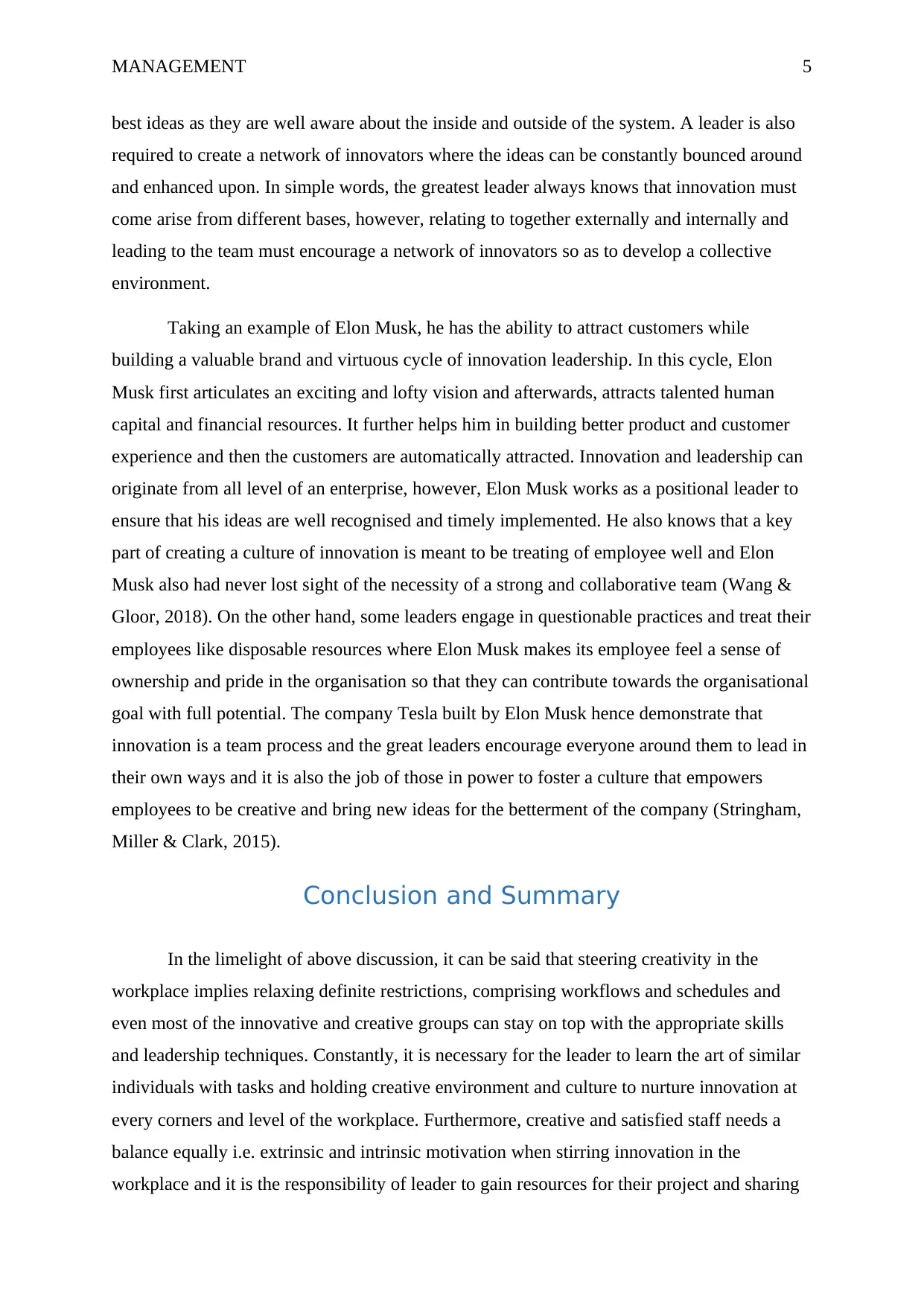
MANAGEMENT 5
best ideas as they are well aware about the inside and outside of the system. A leader is also
required to create a network of innovators where the ideas can be constantly bounced around
and enhanced upon. In simple words, the greatest leader always knows that innovation must
come arise from different bases, however, relating to together externally and internally and
leading to the team must encourage a network of innovators so as to develop a collective
environment.
Taking an example of Elon Musk, he has the ability to attract customers while
building a valuable brand and virtuous cycle of innovation leadership. In this cycle, Elon
Musk first articulates an exciting and lofty vision and afterwards, attracts talented human
capital and financial resources. It further helps him in building better product and customer
experience and then the customers are automatically attracted. Innovation and leadership can
originate from all level of an enterprise, however, Elon Musk works as a positional leader to
ensure that his ideas are well recognised and timely implemented. He also knows that a key
part of creating a culture of innovation is meant to be treating of employee well and Elon
Musk also had never lost sight of the necessity of a strong and collaborative team (Wang &
Gloor, 2018). On the other hand, some leaders engage in questionable practices and treat their
employees like disposable resources where Elon Musk makes its employee feel a sense of
ownership and pride in the organisation so that they can contribute towards the organisational
goal with full potential. The company Tesla built by Elon Musk hence demonstrate that
innovation is a team process and the great leaders encourage everyone around them to lead in
their own ways and it is also the job of those in power to foster a culture that empowers
employees to be creative and bring new ideas for the betterment of the company (Stringham,
Miller & Clark, 2015).
Conclusion and Summary
In the limelight of above discussion, it can be said that steering creativity in the
workplace implies relaxing definite restrictions, comprising workflows and schedules and
even most of the innovative and creative groups can stay on top with the appropriate skills
and leadership techniques. Constantly, it is necessary for the leader to learn the art of similar
individuals with tasks and holding creative environment and culture to nurture innovation at
every corners and level of the workplace. Furthermore, creative and satisfied staff needs a
balance equally i.e. extrinsic and intrinsic motivation when stirring innovation in the
workplace and it is the responsibility of leader to gain resources for their project and sharing
best ideas as they are well aware about the inside and outside of the system. A leader is also
required to create a network of innovators where the ideas can be constantly bounced around
and enhanced upon. In simple words, the greatest leader always knows that innovation must
come arise from different bases, however, relating to together externally and internally and
leading to the team must encourage a network of innovators so as to develop a collective
environment.
Taking an example of Elon Musk, he has the ability to attract customers while
building a valuable brand and virtuous cycle of innovation leadership. In this cycle, Elon
Musk first articulates an exciting and lofty vision and afterwards, attracts talented human
capital and financial resources. It further helps him in building better product and customer
experience and then the customers are automatically attracted. Innovation and leadership can
originate from all level of an enterprise, however, Elon Musk works as a positional leader to
ensure that his ideas are well recognised and timely implemented. He also knows that a key
part of creating a culture of innovation is meant to be treating of employee well and Elon
Musk also had never lost sight of the necessity of a strong and collaborative team (Wang &
Gloor, 2018). On the other hand, some leaders engage in questionable practices and treat their
employees like disposable resources where Elon Musk makes its employee feel a sense of
ownership and pride in the organisation so that they can contribute towards the organisational
goal with full potential. The company Tesla built by Elon Musk hence demonstrate that
innovation is a team process and the great leaders encourage everyone around them to lead in
their own ways and it is also the job of those in power to foster a culture that empowers
employees to be creative and bring new ideas for the betterment of the company (Stringham,
Miller & Clark, 2015).
Conclusion and Summary
In the limelight of above discussion, it can be said that steering creativity in the
workplace implies relaxing definite restrictions, comprising workflows and schedules and
even most of the innovative and creative groups can stay on top with the appropriate skills
and leadership techniques. Constantly, it is necessary for the leader to learn the art of similar
individuals with tasks and holding creative environment and culture to nurture innovation at
every corners and level of the workplace. Furthermore, creative and satisfied staff needs a
balance equally i.e. extrinsic and intrinsic motivation when stirring innovation in the
workplace and it is the responsibility of leader to gain resources for their project and sharing
⊘ This is a preview!⊘
Do you want full access?
Subscribe today to unlock all pages.

Trusted by 1+ million students worldwide
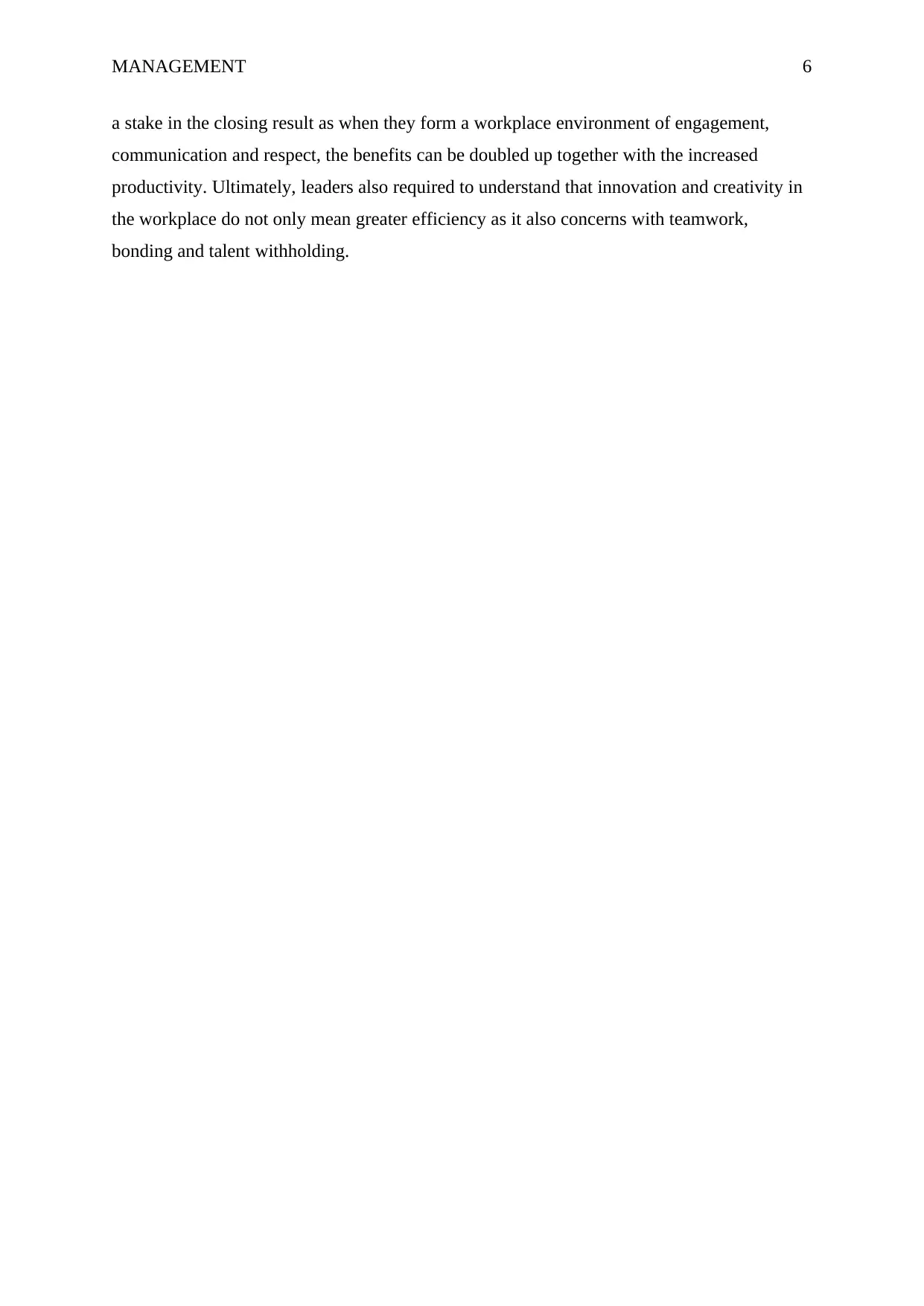
MANAGEMENT 6
a stake in the closing result as when they form a workplace environment of engagement,
communication and respect, the benefits can be doubled up together with the increased
productivity. Ultimately, leaders also required to understand that innovation and creativity in
the workplace do not only mean greater efficiency as it also concerns with teamwork,
bonding and talent withholding.
a stake in the closing result as when they form a workplace environment of engagement,
communication and respect, the benefits can be doubled up together with the increased
productivity. Ultimately, leaders also required to understand that innovation and creativity in
the workplace do not only mean greater efficiency as it also concerns with teamwork,
bonding and talent withholding.
Paraphrase This Document
Need a fresh take? Get an instant paraphrase of this document with our AI Paraphraser
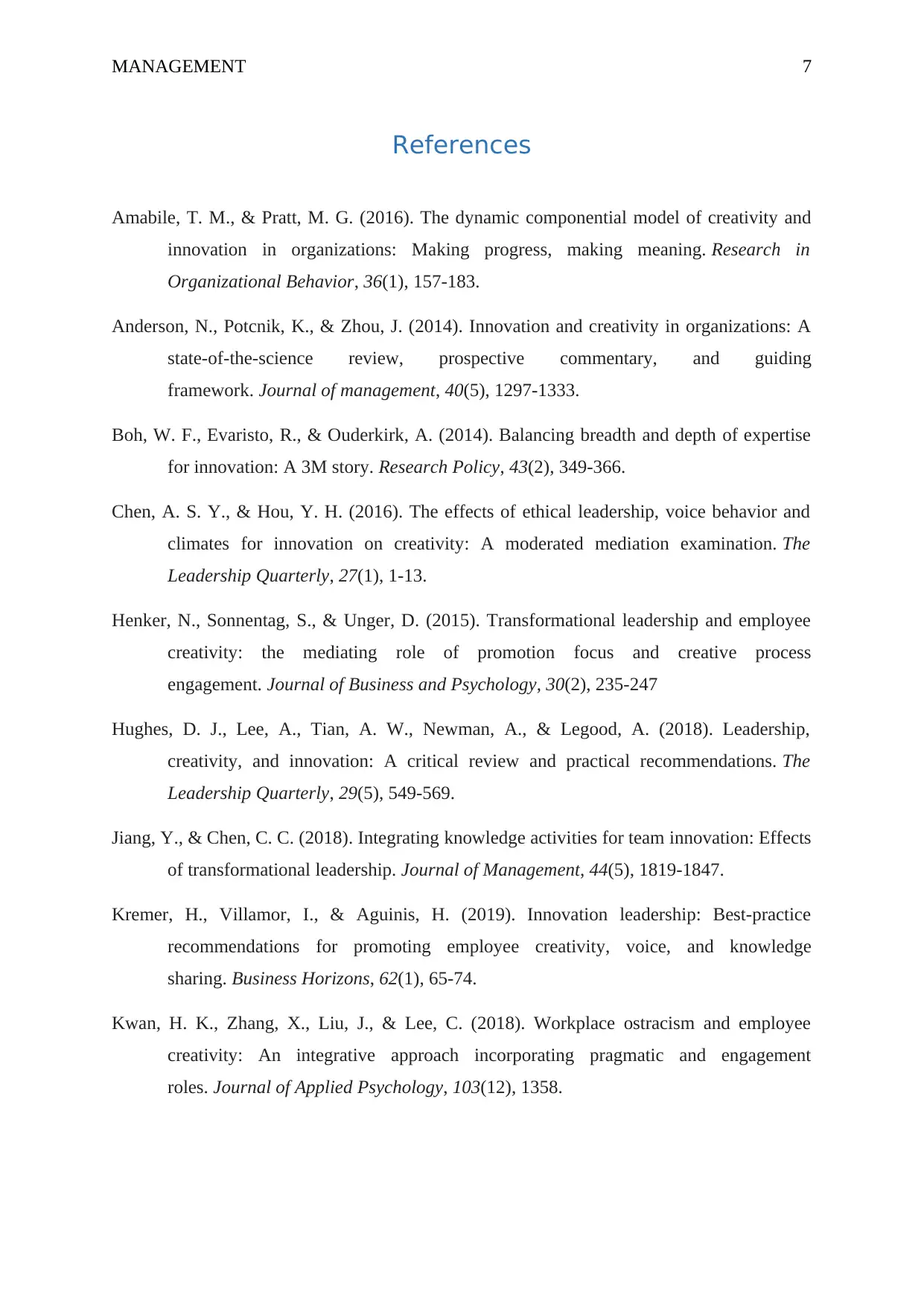
MANAGEMENT 7
References
Amabile, T. M., & Pratt, M. G. (2016). The dynamic componential model of creativity and
innovation in organizations: Making progress, making meaning. Research in
Organizational Behavior, 36(1), 157-183.
Anderson, N., Potcnik, K., & Zhou, J. (2014). Innovation and creativity in organizations: A
state-of-the-science review, prospective commentary, and guiding
framework. Journal of management, 40(5), 1297-1333.
Boh, W. F., Evaristo, R., & Ouderkirk, A. (2014). Balancing breadth and depth of expertise
for innovation: A 3M story. Research Policy, 43(2), 349-366.
Chen, A. S. Y., & Hou, Y. H. (2016). The effects of ethical leadership, voice behavior and
climates for innovation on creativity: A moderated mediation examination. The
Leadership Quarterly, 27(1), 1-13.
Henker, N., Sonnentag, S., & Unger, D. (2015). Transformational leadership and employee
creativity: the mediating role of promotion focus and creative process
engagement. Journal of Business and Psychology, 30(2), 235-247
Hughes, D. J., Lee, A., Tian, A. W., Newman, A., & Legood, A. (2018). Leadership,
creativity, and innovation: A critical review and practical recommendations. The
Leadership Quarterly, 29(5), 549-569.
Jiang, Y., & Chen, C. C. (2018). Integrating knowledge activities for team innovation: Effects
of transformational leadership. Journal of Management, 44(5), 1819-1847.
Kremer, H., Villamor, I., & Aguinis, H. (2019). Innovation leadership: Best-practice
recommendations for promoting employee creativity, voice, and knowledge
sharing. Business Horizons, 62(1), 65-74.
Kwan, H. K., Zhang, X., Liu, J., & Lee, C. (2018). Workplace ostracism and employee
creativity: An integrative approach incorporating pragmatic and engagement
roles. Journal of Applied Psychology, 103(12), 1358.
References
Amabile, T. M., & Pratt, M. G. (2016). The dynamic componential model of creativity and
innovation in organizations: Making progress, making meaning. Research in
Organizational Behavior, 36(1), 157-183.
Anderson, N., Potcnik, K., & Zhou, J. (2014). Innovation and creativity in organizations: A
state-of-the-science review, prospective commentary, and guiding
framework. Journal of management, 40(5), 1297-1333.
Boh, W. F., Evaristo, R., & Ouderkirk, A. (2014). Balancing breadth and depth of expertise
for innovation: A 3M story. Research Policy, 43(2), 349-366.
Chen, A. S. Y., & Hou, Y. H. (2016). The effects of ethical leadership, voice behavior and
climates for innovation on creativity: A moderated mediation examination. The
Leadership Quarterly, 27(1), 1-13.
Henker, N., Sonnentag, S., & Unger, D. (2015). Transformational leadership and employee
creativity: the mediating role of promotion focus and creative process
engagement. Journal of Business and Psychology, 30(2), 235-247
Hughes, D. J., Lee, A., Tian, A. W., Newman, A., & Legood, A. (2018). Leadership,
creativity, and innovation: A critical review and practical recommendations. The
Leadership Quarterly, 29(5), 549-569.
Jiang, Y., & Chen, C. C. (2018). Integrating knowledge activities for team innovation: Effects
of transformational leadership. Journal of Management, 44(5), 1819-1847.
Kremer, H., Villamor, I., & Aguinis, H. (2019). Innovation leadership: Best-practice
recommendations for promoting employee creativity, voice, and knowledge
sharing. Business Horizons, 62(1), 65-74.
Kwan, H. K., Zhang, X., Liu, J., & Lee, C. (2018). Workplace ostracism and employee
creativity: An integrative approach incorporating pragmatic and engagement
roles. Journal of Applied Psychology, 103(12), 1358.
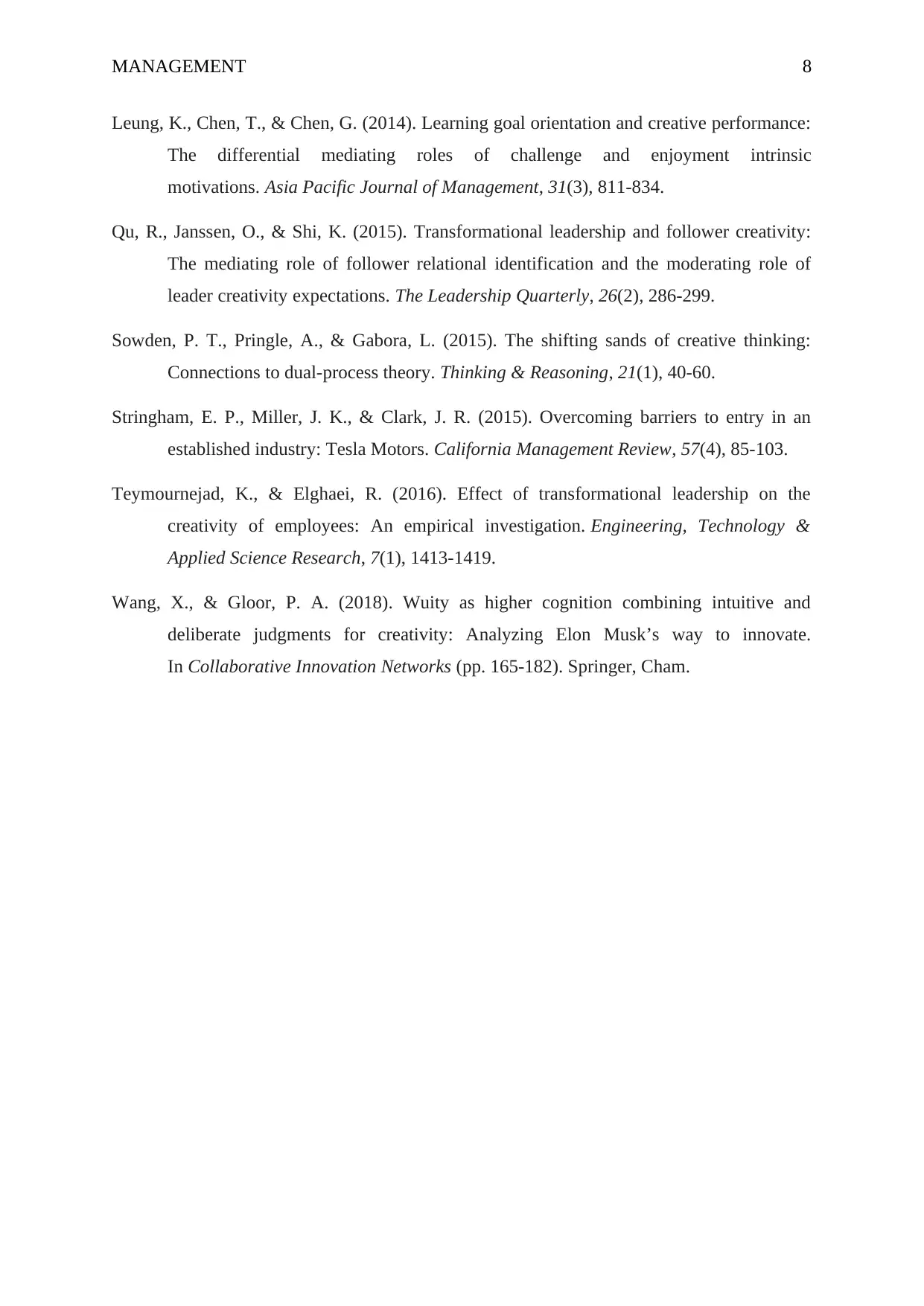
MANAGEMENT 8
Leung, K., Chen, T., & Chen, G. (2014). Learning goal orientation and creative performance:
The differential mediating roles of challenge and enjoyment intrinsic
motivations. Asia Pacific Journal of Management, 31(3), 811-834.
Qu, R., Janssen, O., & Shi, K. (2015). Transformational leadership and follower creativity:
The mediating role of follower relational identification and the moderating role of
leader creativity expectations. The Leadership Quarterly, 26(2), 286-299.
Sowden, P. T., Pringle, A., & Gabora, L. (2015). The shifting sands of creative thinking:
Connections to dual-process theory. Thinking & Reasoning, 21(1), 40-60.
Stringham, E. P., Miller, J. K., & Clark, J. R. (2015). Overcoming barriers to entry in an
established industry: Tesla Motors. California Management Review, 57(4), 85-103.
Teymournejad, K., & Elghaei, R. (2016). Effect of transformational leadership on the
creativity of employees: An empirical investigation. Engineering, Technology &
Applied Science Research, 7(1), 1413-1419.
Wang, X., & Gloor, P. A. (2018). Wuity as higher cognition combining intuitive and
deliberate judgments for creativity: Analyzing Elon Musk’s way to innovate.
In Collaborative Innovation Networks (pp. 165-182). Springer, Cham.
Leung, K., Chen, T., & Chen, G. (2014). Learning goal orientation and creative performance:
The differential mediating roles of challenge and enjoyment intrinsic
motivations. Asia Pacific Journal of Management, 31(3), 811-834.
Qu, R., Janssen, O., & Shi, K. (2015). Transformational leadership and follower creativity:
The mediating role of follower relational identification and the moderating role of
leader creativity expectations. The Leadership Quarterly, 26(2), 286-299.
Sowden, P. T., Pringle, A., & Gabora, L. (2015). The shifting sands of creative thinking:
Connections to dual-process theory. Thinking & Reasoning, 21(1), 40-60.
Stringham, E. P., Miller, J. K., & Clark, J. R. (2015). Overcoming barriers to entry in an
established industry: Tesla Motors. California Management Review, 57(4), 85-103.
Teymournejad, K., & Elghaei, R. (2016). Effect of transformational leadership on the
creativity of employees: An empirical investigation. Engineering, Technology &
Applied Science Research, 7(1), 1413-1419.
Wang, X., & Gloor, P. A. (2018). Wuity as higher cognition combining intuitive and
deliberate judgments for creativity: Analyzing Elon Musk’s way to innovate.
In Collaborative Innovation Networks (pp. 165-182). Springer, Cham.
⊘ This is a preview!⊘
Do you want full access?
Subscribe today to unlock all pages.

Trusted by 1+ million students worldwide
1 out of 9
Related Documents
Your All-in-One AI-Powered Toolkit for Academic Success.
+13062052269
info@desklib.com
Available 24*7 on WhatsApp / Email
![[object Object]](/_next/static/media/star-bottom.7253800d.svg)
Unlock your academic potential
Copyright © 2020–2025 A2Z Services. All Rights Reserved. Developed and managed by ZUCOL.




